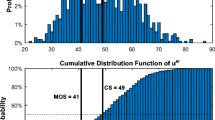Abstract
Several Linear Programming (LP) and Mixed Integer Programming (MIP) models for the production and capacity planning problems with uncertainty in demand are proposed. In contrast to traditional mathematical programming approaches, we use scenarios to characterize the uncertainty in demand. Solutions are obtained for each scenario and then these individual scenario solutions are aggregated to yield a nonanticipative or implementable policy. Such an approach makes it possible to model nonstationarity in demand as well as a variety of recourse decision types. Two scenario-based models for formalizing implementable policies are presented. The first model is a LP model for multi-product, multi-period, single-level production planning to determine the production volume and product inventory for each period, such that the expected cost of holding inventory and lost demand is minimized. The second model is a MIP model for multi-product, multi-period, single-level production planning to help in sourcing decisions for raw materials supply. Although these formulations lead to very large scale mathematical programming problems, our computational experience with LP models for real-life instances is very encouraging.
Similar content being viewed by others
References
M. Alvarez, C.M. Cuevas, L.F. Escudero, J.L. de la Fuente, C. Garcia and F.J. Prieto, Linear networks with uncertainty. An application field for parallel computing in optimization,Netflow 93, Pisa, Italy (1993).
J.B. Birge, An L-shaped method computer code for multi-stage stochastic linear programs, in:Numerical Techniques for Stochastic Optimization, eds. Y. Ermoliev and R.J-B Wets (Springer, Berlin, 1987) pp. 255–266.
G.R. Bitran and H.H. Yanasse, Deterministic approximation to stochastic production problems, Oper. Res. 32(1984)999–1018.
G.B. Dantzig and P.W. Glynn, Parallel processors for planning under uncertainty, Ann. Oper. Res. 22(1990)1–21.
R.S. Dembo, Scenario immunization, Ann. Oper. Res. 30(1991)63–80.
R.S. Dembo and A.J. King, Tracking models and the optimal regret distribution in asset allocation, RC-17156, IBM T.J. Watson Research Center, Yorktown Heights, NY (1991).
B.P. Dzielinski and R.E. Gomory, Optimal programming of lot sizes, inventory and lot size allocations, Manag. Sci. 11(1965)874–890.
R. Entriken and G. Infanger, Decomposition and importance sampling for stochastic linear models, Research Report RC-15545, IBM T.J. Watson Research Center, Yorktown Heights, NY (1990).
Y. Ermoliev and R.J-B. Wets (eds.),Numerical Techniques for Stochastic Optimization (Springer, Berlin, 1990).
L.F. Escudero, CMIT: a capacitated multi-level implosion tool for production planning, IBM T.J. Watson Research Center, Yorktown Heights, NY (1991).
L.F. Escudero and P.V. Kamesam, On solving stochastic production planning problems via scenario analysis, RC-17868, IBM T.J. Watson Research Center, Yorktown Heights, NY (1992).
G.D. Eppen, R.K. Martin and L. Schrage, A scenario approach to capacity planning, Oper. Res. 37(1989)517–527.
M. Florian and M. Klein, Deterministic production planning with concave costs and capacity constraints, Manag. Sci. 18(1971)12–20.
H.I. Grassmann, MSLiP: A computer code for the multistage stochastic linear programming problem, Math. Progr. 47(1990)407–423.
S.C. Graves, A tactical planning model for a job shop, Oper. Res. 34(1986)522–533.
S.C. Graves and C.H. Fine, A tactical planning model for manufacturing subcomponents of mainframe computers, J. Manufac. Oper. Manag. 2(1988)4–34.
IBM, OSL, Optimization Subroutine Library, Guide and Reference, SC23-0519 (1990).
G. Infanger, Monte Carlo (importance) sampling within a Benders decomposition algorithm for stochastic linear programs, Technical Report SOl89-13, Systems Optimization Laboratory, Stanford University, CA (1989).
U.S. Karmakar, Capacity loading and release planning with work in progress and lead times, J. Manufac. Oper. Manag. 2(1989)105–123.
U.S. Karmakar, Lot sizes, lead times and in process inventories, Manag. Sci. 33(1987)409–423.
S. Kekre and S. Kekre, Work-in-process considerations in job shop capacity planning, Working Paper GSIA, Carnegie Mellon University (1985).
L.S. Lasdon and R.C. Terjung, An efficient algorithm for multi-echelon scheduling, Oper. Res. 19(1971)946–969.
I.J. Lustig, J.M. Mulvey and T.J. Carpenter, Formulating stochastic programs for interior point methods, Oper. Res. 39(1991)757–769.
F. Mobasheri, L.H. Orren and E.P. Sioshansi, Scenario planning at Southern California Edison, Interfaces 19(1989)31–44.
J.M. Mulvey, R.J. Vanderbei and S.A. Zenios, Robust optimization of large-scale systems: General modelling framework and computations, Report 91-06-04, The Wharton School, University of Pennsylvania, Philadelphia, PA (1991).
J.M. Mulvey and H. Vladimirou, Stochastic network optimization models for investment planning, Ann. Oper. Res. 20(1989)187–217.
S.S. Nielsen and S.A. Zenios, A massively parallel algorithm for nonlinear stochastic network problems, Report 90-09-08, The Wharton School, University of Pennsylvania, Philadelphia, PA (1990), to appear in Oper. Res.
R.T. Rockafellar and R.J-B Wets, Scenario and policy aggregation in optimization under uncertainty, IIASA Working Paper WP-87-119, 1987, Laxenburg, Austria. See also Math. Oper. Res. 16(1991)119–147.
A. Ruszczynski, Regularized decomposition and augmented Lagrangian decomposition for angular programming problems, in:Aspiration Based Decision Support Systems, ed. A. Levandowski and A.P. Wierzbicki (Springer, Berlin, 1989).
R. Van Slyke and R.J-B. Wets, L-shaped linear programs with application to optimal control and stochastic programming, SIAM J. Appl. Math. 17(1969)638–663.
R.J-B. Wets, The aggregation principle in scenario analysis and stochastic optimization, in:Algorithms and Model Formulations in Mathematical Programming, ed. S.W. Wallace (Springer, Berlin, 1989) pp. 92–113.
P.H. Zipkin, Models for design and control of stochastic multi-item batch production systems, Oper. Res. 34(1986)91–104.
Author information
Authors and Affiliations
Rights and permissions
About this article
Cite this article
Escudero, L.F., Kamesam, P.V., King, A.J. et al. Production planning via scenario modelling. Ann Oper Res 43, 309–335 (1993). https://doi.org/10.1007/BF02025089
Issue Date:
DOI: https://doi.org/10.1007/BF02025089




